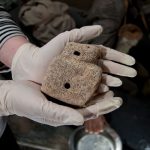

Rediscovered: 5,000-year-old figurine from Skara Brae

A long lost Neolithic human figurine, found at Skara Brae in the 1860s, has been rediscovered in the collections of Stromness Museum.
Dr David Clarke identified the figurine among artefacts from Skaill House donated to the museum without provenance in the 1930s, while undertaking research on Skara Brae funded by Historic Environment Scotland.
The representation has been carved from a piece of whalebone and measures 9.5cm high by 7.5cm wide. Eyes and a mouth have been cut in the face and the body has a navel, but is otherwise unadorned. Holes through the head and body may have been used to suspend the figurine.
The figurine was originally discovered by William G. Watt, the local laird, when excavating a stone bed compartment in House 3 of the Neolithic village.
Watt’s find was briefly described as a “idol” or “fetish” in a report of discoveries at Skara Brae by the antiquarian George Petrie in 1867, but was otherwise only known by a sketch in Petrie’s notebooks, now held in the manuscripts of the Society of Antiquaries of Scotland.
Prehistoric representations of the human form are exceptionally rare in Britain. This figurine was the first Neolithic example discovered, but was largely forgotten. It can now be compared with three smaller figurines discovered in recent excavations on the Neolithic settlement at the Links of Noltland, Westray.
This understated, but hugely important figurine, nicknamed the “Skara Brae Buddo”, is now being displayed for the first time in Stromness Museum alongside artefacts from Skara Brae that have not previously been displayed.